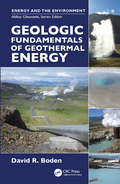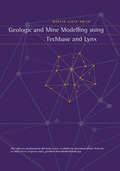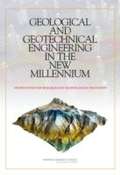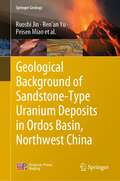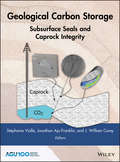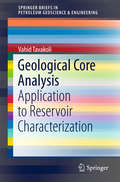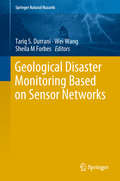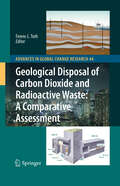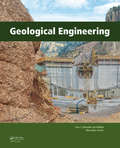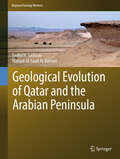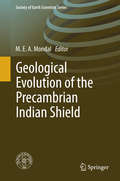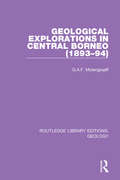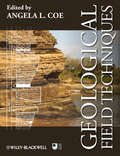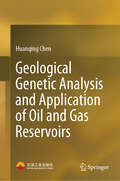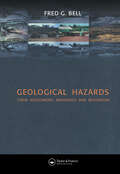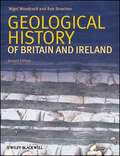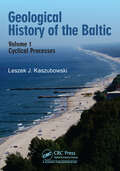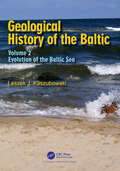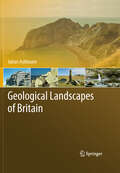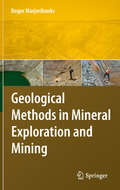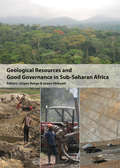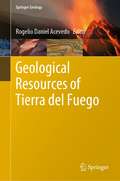- Table View
- List View
Geologic Disasters and the Environment Laboratory Manual
by Robert Leighty Donna Benson Chloe Branciforte Kelli WakefieldMesa College Geology 111 Lab Manual
Geologic Fundamentals of Geothermal Energy
by David R. BodenGeothermal energy stands out because it can be used as a baseload resource. This book, unlike others, examines the geology related to geothermal applications. Geology dictates (a) how geothermal resources can be found, (b) the nature of the geothermal resource (such as liquid- or vapor-dominated) and (c) how the resource might be developed ultimately (such as flash or binary geothermal plants). The compilation and distillation of geological elements of geothermal systems into a single reference fills a notable gap.
Geologic Structures of the Arctic Basin
by Alexey Piskarev Victor Poselov Valery KaminskyThis book contains the most complete description of the geologic and geophysical data of the structure of Arctic Basin including structures of the earth’s crust, crustal and acoustic basement, and sedimentary cover. The book includes information about extracted and studied cores and samples; observed, processed and interpreted data on geophysical anomalies and different conceptions, and a hypotheses of the origin of the modern Arctic Basin structures. Progress in solving the problems of the Arctic Basin geology is presented in the chapters and include contributions from leading field experts.
Geologic Trips: San Francisco and the Bay Area
by Ted KonigsmarkThis book is written for the non-geologist and describes seven geologic trips that will give the reader an understanding of the rocks, faults, earthquakes, and landforms of San Francisco and the Bay Area.
Geologic and Mine Modelling Using Techbase and Lynx
by Martin SmithThis text provides a process oriented discussion of the theory, methodology and philosophy of geologic and mine modelling using two commercial software packages: Techbase, a leader for mineral exploration and modelling bedded deposits; and Lynx, for modelling geology.
Geological And Geotechnical Engineering In The New Millennium: Opportunities For Research And Technological Innovation
by National Research Council of the National AcademiesThe National Academies Press (NAP)--publisher for the National Academies--publishes more than 200 books a year offering the most authoritative views, definitive information, and groundbreaking recommendations on a wide range of topics in science, engineering, and health. Our books are unique in that they are authored by the nation's leading experts in every scientific field.
Geological Background of Sandstone-Type Uranium Deposits in Ordos Basin, Northwest China (Springer Geology)
by Ruoshi Jin Ren’an Yu Peisen MiaoThis book introduces the geological background of sandstone-type uranium deposits in the Ordos Basin, Northwest China. Through comparative study of a large number of practical data such as uranium, coal and oil boreholes, the research system takes sedimentary basin as a unit and fully utilizes geologicalprinciples and test analysis to study the basic geological, geophysical, geochemical and remote sensing image characteristics of the basin, and to restores the favorable uranium-forming geological background brought by the change of the cognitive sedimentary environment conditions. It can be used as a reference for researchers, practitioners and as well as teachers and graduate students working in uranium deposit geology, sedimentary geology and related areas
Geological Carbon Storage: Subsurface Seals and Caprock Integrity (Geophysical Monograph Series #238)
by Stéphanie Vialle Jonathan Ajo-Franklin J. William CareyGeological Carbon Storage Subsurface Seals and Caprock Integrity Seals and caprocks are an essential component of subsurface hydrogeological systems, guiding the movement and entrapment of hydrocarbon and other fluids. Geological Carbon Storage: Subsurface Seals and Caprock Integrity offers a survey of the wealth of recent scientific work on caprock integrity with a focus on the geological controls of permanent and safe carbon dioxide storage, and the commercial deployment of geological carbon storage. Volume highlights include: Low-permeability rock characterization from the pore scale to the core scale Flow and transport properties of low-permeability rocks Fundamentals of fracture generation, self-healing, and permeability Coupled geochemical, transport and geomechanical processes in caprock Analysis of caprock behavior from natural analogues Geochemical and geophysical monitoring techniques of caprock failure and integrity Potential environmental impacts of carbon dioxide migration on groundwater resources Carbon dioxide leakage mitigation and remediation techniques Geological Carbon Storage: Subsurface Seals and Caprock Integrity is an invaluable resource for geoscientists from academic and research institutions with interests in energy and environment-related problems, as well as professionals in the field.
Geological Core Analysis: Application To Reservoir Characterization (Springerbriefs In Petroleum Geoscience And Engineering Ser.)
by Vahid TavakoliThis book offers a compact guide to geological core analysis, covering both theoretical and practical aspects of geological studies of reservoir cores. It equips the reader with the knowledge needed to precisely and accurately analyse cores. The book begins by providing a description of a coring plan, coring, and core sampling and continues with a sample preparation for geological analysis. It then goes on to explain how the samples are named, classified and integrated in order to understand the geological properties that dictate reservoir characteristics. Subsequently, porosity and permeability data derived from routine experiments are combined to define geological rock types and reduce reservoir heterogeneity. Sequence stratigraphy is introduced for reservoir zonation. Core log preparation is also covered, allowing reservoirs to be analysed even more accurately. As the study of core samples is the only way to accurately gauge reservoir properties, this book provides a useful guide for all geologists and engineers working with subsurface samples.
Geological Disaster Monitoring Based on Sensor Networks (Springer Natural Hazards)
by Wei Wang Tariq S. Durrani Sheila M ForbesThis book presents the outcomes of the workshop sponsored by the National Natural Sciences Foundation of China and the UK Newton Fund, British Council Researcher Links. The Workshop was held in Harbin, China, from 14 to 17 July 2017, and brought together some thirty young (postdoctoral) researchers from China and the UK specializing in geosciences, sensor signal networks and their applications to natural disaster recovery.The Workshop presentations covered the state of the art in the area of disaster recovery and blended wireless sensor systems that act as early warning systems to mitigate the consequences of disasters and function as post-disaster recovery vehicles.This book promotes knowledge transfer and helps readers explore and identify research opportunities by highlighting research outcomes in the internationally relevant area of disaster recovery and mitigation.
Geological Disposal of Carbon Dioxide and Radioactive Waste: A Comparative Assessment
by Ferenc L. TothFossil fuels will remain the backbone of the global energy economy for the foreseeable future. The contribution of nuclear energy to the global energy supply is also expected to increase. With the pressing need to mitigate climate change and reduce greenhouse gas emissions, the fossil energy industry is exploring the possibility of carbon dioxide disposal in geological media. Geological disposal has been studied for decades by the nuclear industry with a view to ensuring the safe containment of its wastes. Geological disposal of carbon dioxide and that of radioactive waste gives rise to many common concerns in domains ranging from geology to public acceptance. In this respect, comparative assessments reveal many similarities, ranging from the transformation of the geological environment and safety and monitoring concerns to regulatory, liability and public acceptance issues. However, there are profound differences on a broad range of issues as well, such as the quantities and hazardous features of the materials to be disposed of, the characteristics of the targeted geological media, the site engineering technologies involved and the timescales required for safe containment at the disposal location. There are ample opportunities to learn from comparisons and to derive insights that will assist policymakers responsible for national energy strategies and international climate policies.
Geological Engineering
by Luis Gonzalez de VallejoA thorough knowledge of geology is essential in the design and construction of infrastructures for transport, buildings and mining operations; while an understanding of geology is also crucial for those working in urban, territorial and environmental planning and in the prevention and mitigation of geohazards.Geological Engineering provides an inte
Geological Evolution of Qatar and the Arabian Peninsula (Regional Geology Reviews)
by Fadhil N. Sadooni Hamad Al-Saad Al-KuwariThis is the first book on the geology of Qatar, with a special focus on its petroleum and gas potential, which is studied within the context of the Arabian Plate tectonic configuration. The book consists of nine chapters that introduce the history of Qatar's geologic surveys, the country's surface geology and its main outcrops and physiographic subdivision, the tectonic history, and structural elements of the Arabian Plate and Qatar. The remaining six chapters cover the stratigraphic and sedimentological history of the subsurface sediments of Qatar from the Infra Cambrian to the recent regional correlation with the neighbouring countries.
Geological Evolution of the Precambrian Indian Shield (Society Of Earth Scientists Ser.)
by M. E. A. MondalThis book presents findings from research into the Precambrian history of the Indian shield obtained using state-of-the-art technology. It demonstrates a paradigm shift towards studying the Precambrian shield regions using petrological, geochemical, structural, metallogenic, sedimentological and paleobiological data from the rocks in the Precambrian shield area, and presents a collection of contributions on these diverse topics that help to reconstruct the Precambrian evolution of the Indian Shield.
Geological Explorations in Central Borneo (Routledge Library Editions: Geology #11)
by G.A.F. MolengraaffThis book, first published in 1902, is the product of the detailed geological survey undertaken by the Borneo Expedition of the late nineteenth century. The scientific exploration focused on Central Borneo, especially the sources of the Kapoewas and its tributaries, and its analysis of the geology of the region still today forms the bedrock of research into the area.
Geological Field Techniques
by Angela L. CoeThe understanding of Earth processes and environments over geological time is highly dependent upon both the experience that can only be gained through doing fieldwork, and the collection of reliable data and appropriate samples in the field. This textbook explains the main data gathering techniques used by geologists in the field and the reasons for these, with emphasis throughout on how to make effective field observations and record these in suitable formats. Equal weight is given to assembling field observations from igneous, metamorphic and sedimentary rock types. There are also substantial chapters on producing a field notebook, collecting structural information, recording fossil data and constructing geological maps. The volume is in a robust and handy size, with colour coded chapters for ease of use and quick reference in the field.Geological Field Techniques is designed for students, amateur enthusiasts and professionals who have a background in geology and wish to collect field data on rocks and geological features. Teaching aspects of this textbook include:step-by-step guides to essential practical skills such as using a compass-clinometer, making a geological map and drawing a field sketch;tricks of the trade, checklists, flow charts and short worked examples;over 200 illustrations of a wide range of field notes, maps and geological features;appendices with the commonly used rock description and classification diagrams;a supporting website hosted by Wiley Blackwell.
Geological Genetic Analysis and Application of Oil and Gas Reservoirs
by Huanqing ChenThis book presents the research on geological genetic analysis of oil and gas reservoirs. It expounds on the methods, problems, and prospects of geological genetic analyses of oil and gas reservoirs, considering structures, reservoirs, and oil–gas–water (OGW) systems. Then, it explains the application of geological genetic analysis of oil and gas reservoirs with examples of volcanic rocks in the Songliao Basin, glutenites in the northwestern Junggar Basin, and sandstones in the Liaohe Basin. It is a valuable reference for researchers, engineers, and graduate students engaged in oil/gas exploration both from industrial and academic sectors.
Geological Hazards: Their Assessment, Avoidance and Mitigation
by Fred G. BellNatural hazards cost the global economy over $50,000 million per year. Two thirds of this is spent on damage repair, the remainder represents the cost of predicting, preventing and mitigating against disasters. Man-made hazards such as groundwater pollution, subsidence and soil erosion add to this figure. Geological Hazards presents a state-of-the-art survey and examines methods of assessing, evaluating and combating hazards, both natural and man-made.
Geological History of Britain and Ireland
by Rob Strachan Nigel H. WoodcockBritain and Ireland have a remarkably varied geology for so small a fragment of continental crust, with a fine rock record back through three billion years of geological time. This history would have been interesting enough if it had been played out on relatively stable continental crust. However, Britain and Ireland have developed at a tectonic crossroads, on crust once traversed by subduction zones and volcanic arcs, continental rifts and mountain belts. The resulting complexity is instructive, fascinating and perplexing.Geological History of Britain and Ireland tells the region's story at a level accessible to undergraduate geologists, as well as to postgraduates, professionals or informed amateurs. This second edition is fully revised and updated, reflecting our continually developing knowledge of the region's geology. Full coverage is again given to the rich Precambrian and Early Palaeozoic history, as well as to later events more relevant to hydrocarbon exploration. The book is an essential starting point for more detailed studies of the regional geology.Additional resources for this book can be found at: http://www.wiley.com/go/woodcock/geologicalhistory
Geological History of the Baltic: Volume 1: Cyclical Processes
by Leszek J. KaszubowskiThe book presents the cyclicity and micro-cyclicity phenomena which occurred during climate changes and during marine transgressions and regressions. As calculated by the author on the basis of geological research, the climatic cycle of the Earth allows a better understanding of climate changes and associated geological processes in the last 20,000 years. In addition, the author discusses the structure of the sub-Quaternary bedrock and analyses complex geological structures of the Baltic Sea Quaternary deposits. Individual chapters address key aspects of: tectonic and geological analysis of the Baltic Sea basin detailed tectonic and geological analysis of the Polish Baltic Sea and Polish coastal zone global geotectonic cycles of the supercontinents cyclicity and micro-cyclicity arising in the atmosphere and hydrosphere of the Earth the climatic cycle of the Earth, presented for a better understanding of climate changes and associated geological processes in the last 20,000 years calculating the extent of the influence of climate change and tectonic movements on marine transgressions and regressions simulation and correlation of the 310-year climate cycle predicted future Earth climate cycles in the Northern Hemisphere The book will be useful for students and scientists of marine geology, oceanography, geography and environmental engineering. It will also be of practical utility for all specialists dealing with marine basins and coastal zones, including marine geologists, coastal geologists and geomorphologists, geographers, as well as engineering geologists, geotechnicians and civil engineers. The book is generally related to the discipline of marine geology, and deals directly with the Baltic Sea basin. However, the climate cycle of the Earth, which affects the course of marine transgressions and regressions, has a supra-regional dimension.
Geological History of the Baltic: Volume 2: Evolution of the Baltic Sea
by Leszek J. KaszubowskiThis book presents the geological evolution of the Baltic Sea area since its inception, i.e., from the Late Glacial to the present day. The geological history of all evolutionary stages of the Baltic Sea is discussed in detail, from the Baltic Ice Lake, through the Yoldia Sea, Ancylus Lake, Littorina Sea and Lymnaea Sea, to the Mya Sea as the modern stage of the Baltic Sea development. The author presents palaeoecological and palaeosedimentological analyses of various evolutionary stages of the Baltic Sea. Detailed paleogeographic maps of the development of the Littorina Sea, Lymnaea Sea and Mya Sea are displayed, with particular focus on the Polish Baltic Sea area. Moreover, characteristic geological cross-sections and synthetic stratigraphic profiles representing individual areas of the Polish Baltic Sea coast are also shown. Each transgressive cycle of the various developmental stages of the Baltic Sea is characterized in terms of the average rate of marine transgression, the fluctuation of Baltic levels and the average rate of marine abrasion of the then cliff and spit shores, as well as the evolutionary changes of the area. In addition, the lithostratigraphic characteristics of the various marine sediment complexes and dune sediments (brown dune spits, yellow dune spits, light yellow-grey dune spits and grey dune spits) are also presented. Individual chapters address key aspects of:• Litho-stratigraphical analysis of the Baltic Ice Lake deposits.• Litho-stratigraphical analysis of the Yoldia Sea deposits.• Litho-stratigraphical analysis of the Ancylus Lake deposits.• Paleogeography, litho-stratigraphy and transgressive cycles of the LittorinaSea.• Paleogeography, litho-stratigraphy and transgressive cycles of the LymnaeaSea.• Paleogeography, litho-stratigraphy and transgressive cycles of the Mya Sea.• New stratigraphic division of the southern Baltic deposits along the Polishcoast.The book will be useful for students and scientists of marine geology, oceanography, geography and environmental engineering. It will also be of practical use for all specialists dealing with marine basins and coastal zones, including marine geologists, coastal geologists and geomorphologists, geographers, as well as engineering geologists, geotechnicians and civil engineers. The book is generally related to the discipline of marine geology, and deals directly with the Baltic Sea basin.
Geological Landscapes of Britain
by Julian AshbournThis book discusses the geological history of Britain from the early geological formation of the British Isles, through to the variety of currently visible rock formations and ensuing natural landscapes. It is presented as an accessible narrative which may be utilised in a variety of educational contexts, or simply enjoyed as an holistic overview of the subject. It additionally provides an important visual record of British geology in the 21st century via a portfolio of high quality, scientifically accurate photographs, which are themselves part of a larger collection, being developed to become the definitive image library for British geoscience. In addition, the book provides an insight into the relationship between the geology of Britain and how early settlers interacted with the landscape throughout Mesolithic and Neolithic times. It is a book which serves equally as a scientific reference, an introduction to the subject of British geology and, no doubt, as an edition which will remain a pleasure to own in its own right.
Geological Methods in Mineral Exploration and Mining
by Roger MarjoribanksThis practical step-by-step guide describes the key geological field techniques needed by today's exploration geologists involved in the search for metallic deposits. The techniques described are fundamental to the collection, storage and presentation of geological data and their use to locate ore. This book explains the various tasks which the exploration geologist is asked to perform in the sequence in which they might be employed in an actual exploration project. Hints and tips are give. The steps are illustrated with numerous examples drawn from real projects on which the author has worked. The book emphasizes traditional skills and shows how they can be combined effectively with modern technological approaches.
Geological Resources and Good Governance in Sub-Saharan Africa: Holistic Approaches to Transparency and Sustainable Development in the Extractive Sector
by Jürgen Runge James ShikwatiThis book looks at the distribution, occurrences, potential and prospects for good governance, transparency and sustainable development of geological resources in Sub-Saharan Africa. By bringing together numerous different point of views, it is carried out in a holistic, interdisciplinary and scientific way.The states of Sub-Saharan Africa are amon
Geological Resources of Tierra del Fuego (Springer Geology)
by Rogelio Daniel AcevedoThe CADIC’s Geological Resources Program will soon turn 40 years of fruitful development. During this period many projects were carried out and others remain to be implemented. In the course of time three generations of researchers have been formed. Mentioning names would be unfair to those that could be involuntarily omitted. There is still a long way to go. The eagerness for knowledge should not stop. This book is a tribute to all those people who have worked in the different projects of pure and applied science, and educational, and human resources training, granted to this founding program and associated laboratories of the regional center of CONICET in Ushuaia, Tierra del Fuego, Argentina. The twenty papers which constitute this book have a genuine Latin appeal, having been written by 50 authors based in Argentina and Spain. All this contributions are concerned with Fuegian geological resources. Everyone concerned with this work hopes that it will prove a fitting and lasting memorial to Nacho Subías, whose personal contribution to our knowledge of this geology was outstanding.

